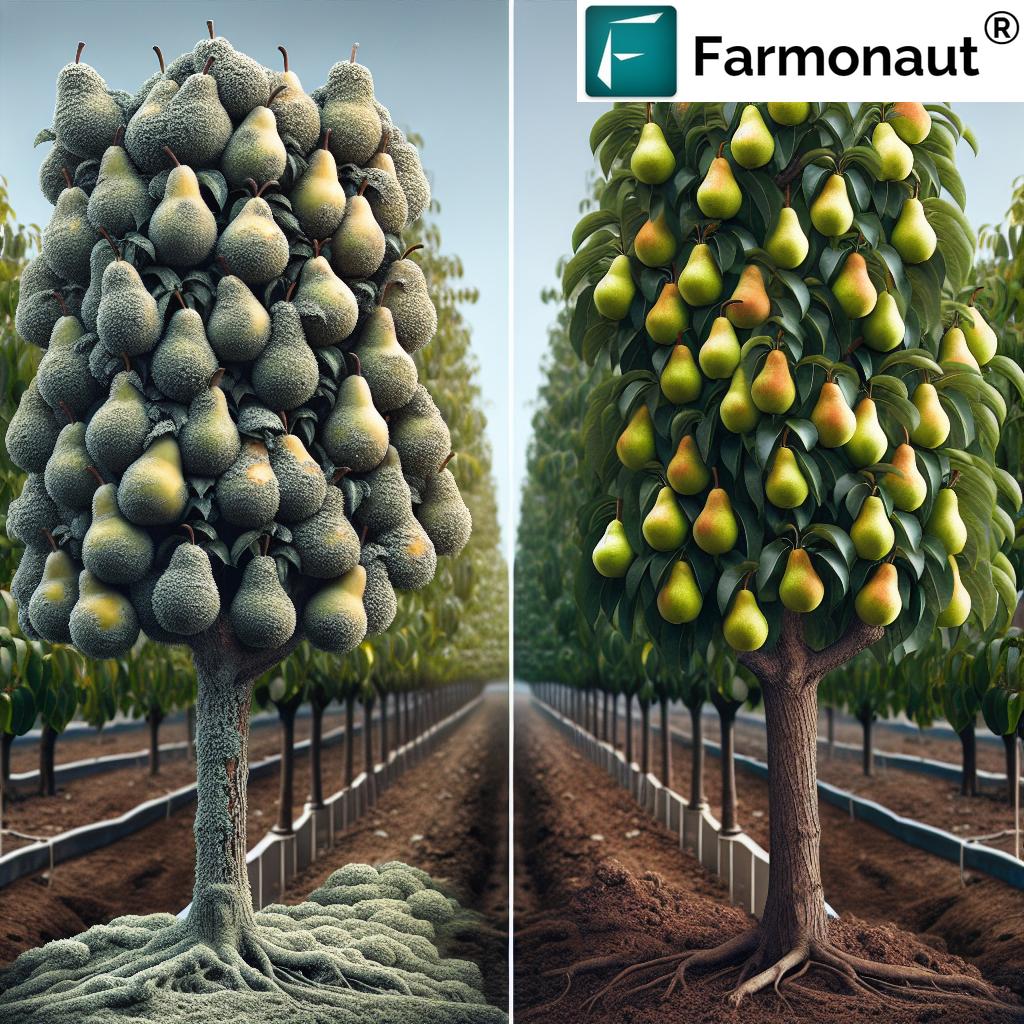Effective Organic and Chemical Treatments for Powdery Mildew Control in Apple and Pear Crops: From Sulfur to Bacillus

At Farmonaut, we understand the critical importance of protecting apple and pear crops from devastating diseases like powdery mildew. This fungal disease, caused by Podosphaera leucotricha, can significantly impact fruit quality and yield, posing a serious threat to orchards worldwide. In this comprehensive guide, we’ll explore effective organic and chemical treatments for powdery mildew control, focusing on sustainable practices and cutting-edge solutions.
Understanding Powdery Mildew in Apple and Pear Crops
Powdery mildew is a persistent fungal disease that affects various plants, including apple and pear trees. It’s characterized by a white, powdery substance on leaves, shoots, and fruits, which can lead to reduced photosynthesis, stunted growth, and deformed fruits. Early detection and proper management are crucial for maintaining healthy orchards and ensuring optimal crop yields.

Traditional vs. Modern Detection Methods
Before diving into treatment options, it’s essential to understand how powdery mildew detection has evolved. Here’s a comparison of traditional methods versus modern satellite-based systems like Farmonaut:
| Feature | Traditional Powdery Mildew Detection | Farmonaut Satellite System |
|---|---|---|
| Detection Speed | Slow, requires manual inspection | Rapid, automated detection |
| Accuracy | Varies based on inspector’s expertise | High accuracy using multispectral imaging |
| Coverage Area | Limited to physically accessible areas | Large-scale coverage of entire orchards |
| Cost-effectiveness | Labor-intensive and time-consuming | Highly cost-effective for large areas |
Farmonaut’s satellite imagery can detect early signs of powdery mildew infestation across large orchards, enabling timely and targeted treatment application. This advanced technology significantly improves disease management efficiency.
Organic Treatments for Powdery Mildew Control
For growers focused on organic production, there are several effective treatments available:
1. Sulfur-based Fungicides
Sulfur has been a go-to organic fungicide for centuries. It’s highly effective against powdery mildew and is approved for use in organic farming.
- Application: Apply as a dust or wettable powder
- Frequency: Every 7-10 days during susceptible periods
- Caution: Avoid applying when temperatures exceed 85°F (29°C) to prevent leaf burn
2. Potassium Bicarbonate
This organic compound disrupts the fungal cell wall and alters pH levels on the leaf surface, making it inhospitable for powdery mildew.
- Application: Mix with water and spray on affected areas
- Frequency: Apply weekly as a preventive measure
- Advantage: Safe for beneficial insects and can be used up to the day of harvest
3. Neem Oil
Neem oil is a natural fungicide and insecticide derived from the neem tree. It’s effective against powdery mildew and other pests.
- Application: Dilute and spray on leaves, ensuring complete coverage
- Frequency: Apply every 7-14 days
- Benefit: Also helps control other common orchard pests
4. Bacillus subtilis
This beneficial bacterium acts as a biocontrol agent against powdery mildew. Products containing Bacillus subtilis are approved for organic use.
- Application: Spray on foliage as per product instructions
- Frequency: Typically applied every 7-10 days
- Advantage: Promotes plant growth while suppressing disease
Chemical Treatments for Powdery Mildew Control
For conventional orchards or severe infestations, chemical fungicides can provide robust protection:
1. Sterol Inhibitors (DMIs)
These fungicides inhibit ergosterol production, essential for fungal cell membrane formation.
- Active Ingredients: Myclobutanil, Fenbuconazole
- Application: Spray at first sign of disease
- Caution: Rotate with other fungicide classes to prevent resistance
2. Strobilurins (QoIs)
Strobilurins work by inhibiting mitochondrial respiration in fungi.
- Active Ingredients: Trifloxystrobin, Kresoxim-methyl
- Application: Apply preventively or at first signs of disease
- Benefit: Also improves plant health and stress tolerance
3. SDHI Fungicides
Succinate dehydrogenase inhibitors (SDHIs) target a specific enzyme in the fungal respiration process.
- Active Ingredients: Fluxapyroxad, Penthiopyrad
- Application: Use as part of a rotational program
- Advantage: Effective against multiple stages of fungal development
Integrated Pest Management (IPM) Strategies
At Farmonaut, we advocate for an integrated approach to powdery mildew control. This involves combining cultural practices, biological controls, and judicious use of fungicides:
1. Cultural Practices
- Pruning: Improve air circulation and sunlight penetration
- Sanitation: Remove and destroy infected plant material
- Resistant Varieties: Plant apple and pear varieties with natural resistance to powdery mildew
2. Biological Controls
- Beneficial Microorganisms: Introduce Ampelomyces quisqualis, a hyperparasite of powdery mildew
- Compost Teas: Apply compost extracts to boost plant immunity
3. Monitoring and Forecasting
Utilize Farmonaut’s satellite-based crop monitoring system to detect early signs of powdery mildew infestation. Our advanced technology allows for:
- Early detection of disease symptoms
- Targeted application of treatments
- Reduced overall fungicide use
- Improved orchard management efficiency
Learn more about our satellite-based monitoring system: Farmonaut Crop Monitoring
Application Techniques for Effective Control
Proper application of treatments is crucial for effective powdery mildew control:
1. Timing
- Apply fungicides preventively, before disease onset
- Use Farmonaut’s weather forecasting API to time applications optimally
- Treat at critical growth stages (e.g., green tip, pink bud, petal fall)
2. Coverage
- Ensure thorough coverage of all plant surfaces, especially undersides of leaves
- Use appropriate spray equipment and nozzles for uniform distribution
- Consider using adjuvants to improve spray retention and spread
3. Rotation
- Alternate between different fungicide classes to prevent resistance development
- Follow label instructions for maximum number of applications per season
- Integrate organic and chemical treatments in a comprehensive program
Resistance Management
Preventing fungicide resistance is crucial for long-term powdery mildew control:
- Rotate fungicides with different modes of action
- Use tank mixes of fungicides with different action mechanisms
- Adhere to recommended application rates and frequencies
- Monitor treatment efficacy and report any suspected resistance
Environmental Considerations
When implementing powdery mildew control measures, it’s essential to consider environmental impacts:
- Choose eco-friendly options when possible
- Follow local regulations regarding pesticide use
- Protect pollinators by avoiding spraying during bloom periods
- Use Farmonaut’s carbon footprinting tool to monitor and reduce environmental impact
Farmonaut’s Role in Powdery Mildew Management
Our advanced satellite-based monitoring system plays a crucial role in effective powdery mildew management:
- Early Detection: Identify potential outbreaks before visible symptoms appear
- Precision Application: Target treatments to specific areas of infestation
- Resource Optimization: Reduce unnecessary fungicide applications
- Data-Driven Decisions: Make informed choices based on real-time crop health data
Explore our satellite-based solutions: Farmonaut Satellite API
Case Studies and Success Stories
While we don’t include specific case studies or success stories, many orchards have successfully implemented integrated powdery mildew management strategies using a combination of cultural practices, organic treatments, and judicious use of chemical fungicides. The key to success lies in early detection, proper timing of applications, and a holistic approach to orchard health.
Future Developments in Powdery Mildew Control
The field of plant disease management is constantly evolving. Some promising areas of research include:
- Development of new, more environmentally friendly fungicides
- Genetic engineering for increased powdery mildew resistance in apple and pear varieties
- Advanced AI-driven disease prediction models
- Novel biological control agents
At Farmonaut, we’re committed to staying at the forefront of these developments and integrating new technologies into our platform to better serve orchardists worldwide.
Conclusion
Effective powdery mildew control in apple and pear orchards requires a multifaceted approach, combining cultural practices, organic treatments, and judicious use of chemical fungicides. By leveraging advanced technologies like Farmonaut’s satellite-based monitoring system, growers can detect infestations early, apply treatments precisely, and optimize resource use.
Remember, the key to successful powdery mildew management lies in prevention, early detection, and timely intervention. By adopting an integrated pest management strategy and utilizing cutting-edge tools, orchardists can protect their crops, improve yields, and ensure the long-term health of their orchards.
For more information on how Farmonaut can help you manage powdery mildew and other orchard challenges, visit our website or download our mobile app:
FAQs
- Q: How often should I apply fungicides for powdery mildew control?
A: The frequency of fungicide applications depends on the product used and disease pressure. Generally, treatments are applied every 7-14 days during susceptible periods. Always follow label instructions and use Farmonaut’s monitoring system to optimize application timing. - Q: Can I use organic and chemical fungicides in the same season?
A: Yes, many growers use both organic and chemical fungicides as part of an integrated pest management strategy. However, ensure compatibility and adhere to pre-harvest intervals for each product. - Q: How does Farmonaut’s satellite monitoring help in powdery mildew management?
A: Our satellite-based system detects early signs of stress in crops, allowing for early intervention before visible symptoms appear. This enables targeted and timely application of treatments, reducing overall fungicide use and improving control efficacy. - Q: Are there any resistant apple or pear varieties I can plant?
A: Yes, several apple and pear varieties have been bred for powdery mildew resistance. Consult with local extension services or nurseries for varieties suitable for your region. - Q: How can I prevent fungicide resistance in my orchard?
A: Rotate between fungicides with different modes of action, use tank mixes when appropriate, and integrate non-chemical control methods. Farmonaut’s platform can help you track and manage your fungicide rotation program effectively.
Ready to take your orchard management to the next level? Subscribe to Farmonaut today and gain access to our advanced satellite-based monitoring system, weather forecasting API, and more!
For more information on our API and developer resources, visit our API Documentation.








